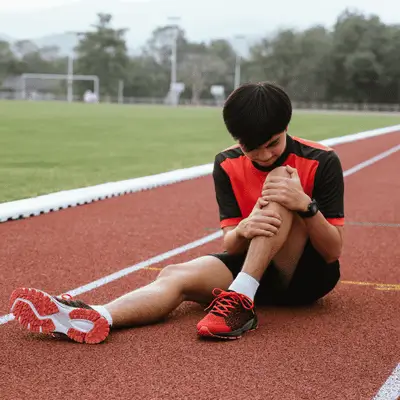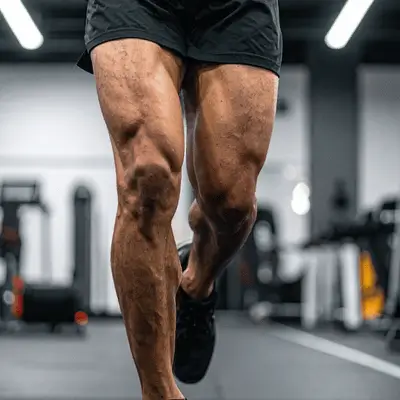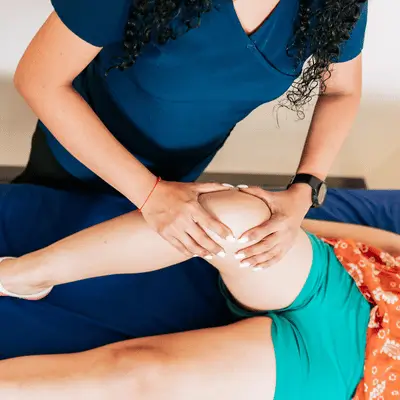Runner’s knee strikes up to 40% of athletes who visit sports clinics. This overuse injury causes sharp knee pain around your kneecap. The medical name is patellofemoral pain syndrome.
Most cases happen when you increase your running volume too fast. Your knee can’t handle the sudden jump in training. Poor knee alignment and muscle weakness make things worse.
The good news? You can fix this problem. Smart runners knee rehab gets you back to pain-free running. Here’s your complete recovery plan.
Why Runner’s Knee Happens

Runner’s knee comes from doing too much too soon. Your patellofemoral joint gets overloaded from repetitive impact. Hills and speed work make it worse.
Muscle imbalances fuel the problem. Weak quads can’t control your kneecap properly. Poor hip strengthening lets your knee cave inward. This creates faulty knee tracking.
Your IT band plays a big role too. When it’s tight, it pulls your knee out of place. Bad biomechanics during running add more stress to the joint.
Think of your knee as part of a chain. Problems at your hip affect knee alignment. Weak core muscles hurt your running form. Everything connects.
Start With Rest and Smart Recovery
Rest is your first step when knee pain flares up. You need to calm down the angry tissues under your kneecap.
Cut back your running volume right away. Skip hills and speed work until pain goes away. This doesn’t mean complete rest.
Try low-impact activities instead. Swimming and cycling maintain fitness without knee stress. The elliptical machine works well too.
When you return to running, go slow. Increase your weekly running volume by just 10%. Your body needs time to adapt. Patience now prevents bigger problems later.
Stretching Exercises That Actually Work
Tight muscles pull your knee out of proper knee alignment. Daily stretching improves flexibility and joint mobility.
Focus on four key areas: hamstrings, quads, calves, and your IT band.
For hamstring stretch, lie on your back. Pull your straight leg toward you with a towel. Hold for 30 seconds on each side.
Stretch your quads by grabbing your ankle behind you. Keep your knees together and push your hip forward.
Your IT band needs special attention. Use foam rolling on your outer thigh. Roll slowly from your hip to your knee. Foam rolling breaks up tight spots and improves tissue quality.
Do this routine twice daily. Morning stretches prepare your muscles for activity. Evening stretches help you recover and maintain flexibility.
Strength Training for Knee Stability

Weakness causes runner’s knee. Strength training fixes the root problem. Target your quads, hips, and core muscles for better joint stability.
Strong quads control your kneecap during impact. Quadriceps strengthening starts with straight leg raises. Lie flat and lift your straight leg 12 inches off the ground. Do 3 sets of 15 reps.
Wall squats build functional strength. Lean against a wall and slide down to 90 degrees. Hold for 30 seconds. Work up to 1 minute holds.
Hip strengthening matters just as much. Weak hip abductor muscles let your knee collapse inward. The clamshell exercise targets these muscles perfectly.
Lie on your side with knees bent. Keep your feet together and lift your top knee. You should feel it in your hip, not your back.
Glute bridges activate your powerful hip muscles. Lie on your back with knees bent. Squeeze your glutes and lift your hips up. Hold for 2 seconds at the top.
Add lunges when you’re stronger. Step forward and drop your back knee toward the ground. Keep your front knee over your ankle. This builds real-world knee stability.
Balance Training and Proprioception
Your knee needs to know where it is in space. This is called proprioception. Injury and muscle weakness mess this up.
Balance training fixes the problem. Start with single-leg stands on solid ground. Work up to 60 seconds per leg.
Make it harder by closing your eyes. Try standing on a foam pad or pillow. These unstable surfaces challenge your balance system.
Add movement to your balance work. Try clock taps while balancing on one leg. Reach your free leg to different positions like clock numbers.
This training improves knee tracking during running. Your muscles learn to react faster when you hit uneven ground.
Fix Your Running Mechanics
Poor running form puts extra stress on your knees. Gait analysis reveals these problems. A physical therapy expert can spot issues you miss during your gait analysis.
Common problems include overstriding and heel striking far in front of your body. This creates huge impact forces at your knee.
Fix this by taking shorter, quicker steps. Aim for 180 steps per minute. Land with your foot closer under your body, not way out in front.
Work on knee alignment during running mechanics practice. Your knee should track straight over your foot. Practice single-leg squats in front of a mirror. Watch for inward knee collapse.
Keep a slight forward lean from your hips. This engages your glutes more and takes load off your knees.
Running mechanics take time to change. Be patient and practice new patterns slowly first.
Advanced Knee Exercises for Athletes
Advanced Knee Exercises for Athletes
Build Power & Control for Injury-Free Performance
Once basic strength improves, add harder knee exercises. Step-ups on a 6-inch box build power and control.
Single-leg squats challenge your entire leg. Start with small ranges and build up slowly. Keep your knee aligned over your foot.
Add plyometric exercises when you’re ready. Small hops and bounds prepare your knee for running impact.
Remember that rehabilitation exercises should never cause sharp pain. Some muscle fatigue is normal, but joint pain means you’re pushing too hard.
Your IT band may stay tight even with stretching. Consider professional help if your IT band doesn’t respond to foam rolling. Physical therapy can provide hands-on treatment.
Prevent Future Injuries
Injury prevention starts with smart training. Never increase running volume more than 10% per week. Your body needs time to adapt to new stress.
Keep doing hip strengthening even after you feel better. Maintenance workouts twice per week prevent the return of patellofemoral pain syndrome.
Replace your running shoes every 300-400 miles. Worn-out shoes change your biomechanics and increase injury risk.
Watch your IT band closely. This tough tissue connects your hip to your knee. When it gets tight, knee tracking suffers and pain returns.
Listen to your body. Small aches and pains are warning signs. Address them before they become real injuries.
When to See a Physical Therapy Expert

Some cases need professional help. See a physical therapy specialist if your knee pain lasts more than 2 weeks with rest.
Sharp, shooting pain during daily activities is another red flag. So is swelling that doesn’t go down with ice and elevation.
A sports physical therapy clinic can provide detailed movement screens. They spot problems you might miss on your own.
Professional treatment uses advanced techniques beyond basic knee exercises. Manual therapy and specialized equipment speed up your recovery.
Don’t wait until you’re completely broken down. Early intervention gets you back faster and prevents chronic problems.
Ready to beat runner’s knee for good? Contact our sports physical therapy team today for a complete movement assessment. We’ll create your personalized recovery plan and get you back to pain-free running faster.
Frequently Asked Questions
How long does runner’s knee take to heal? Most cases improve in 4-6 weeks with proper rest and rehab exercises. Complete recovery may take 8-12 weeks depending on severity and your commitment to treatment.
Can I run with runner’s knee pain? Stop running when you feel pain during or after your workouts. Continuing to run will make the problem worse and delay healing.
What’s the best exercise for runner’s knee? Hip strengthening exercises like clamshells and glute bridges work best for most people. Strong hips improve alignment and reduce patellofemoral stress.
Do I need surgery for runner’s knee? Surgery is rarely needed for this condition. Over 90% of cases respond well to targeted therapy, strength training, and activity changes.

